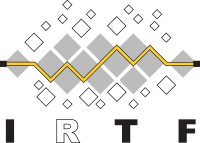The Quantum Internet will bring new communication and remote computation capabilities such as quantum secure communication, distributed quantum computing, and quantum-enhanced physical sensor systems. A key focus area for quantum networks will be cryptographic functions such as quantum key distribution or quantum byzantine agreement.
Work towards a Quantum Internet is well underway in physics laboratories and in theory groups. The next step is network engineering. Being embedded within the IRTF community helps in achieving this goal in two ways:
- The IRTF community has extensive experience in network engineering. Whilst quantum networks operate on a completely new set of physical principles, many lessons have been learned throughout the Internet’s history and many of them will be relevant to the development of the Quantum Internet.
- Quantum networks will be embedded within non-quantum (classical) networks, as they require classical connectivity for control and management purposes. Thus, the IRTF’s experience in classical network design and architecture will be beneficial.
Overall the goal of the QIRG is to address the question of how to design and build quantum networks. Some of the problems that need to be addressed include:
- Routing: Finding an optimal path in a quantum network is a non-trivial problem due to the requirement of achieving a certain fidelity threshold and the low coherence time of quantum memories. There are a number of proposals and which routing schemes are appropriate for which circumstances needs to be assessed.
- Resource allocation: All networks have a finite pool of resources, and quantum networks bring new resource considerations to the table, such as the coherence time of quantum memories. Some of the routing proposals already include a notion of dynamic traffic in the network, but it is worth making a distinction.
- Connection establishment: Quantum networks deliver entangled states instead of packets so the connection semantics may be different. How does such a request look like as it propagates across the network?
- Interoperability: Different networks based on different hardware (ion traps, atomic ensembles, nitrogen vacancy centres) and using different protocols are currently being designed and built. How do we ensure a long-lived internetwork develops?
- Security: Quantum networks bring enhanced security for applications. Therefore, the question of the security of the network itself must also be addressed. Are quantum repeater networks inherently more or less vulnerable in operations than classical networks?
- API design: Classical sockets are built around the concept of bits. What should an API for entangled states look like given new considerations such as fidelity, and the low coherence time of quantum memories?
Some other problems that can be tackled by the QIRG:
- Applications for a Quantum Internet: an important item on the agenda for the community is analyzing how to turn the low-level, abstract functions of quantum communication into services provided by the Quantum Internet, including establishing required data rates and fidelities, with specific use cases incorporating quantum services into complete information systems.
- Multi-party states and multi-party transfers such as network coding: rather than simple, independent point-to-point transfers, how can we create and use more complex states?
Outputs and Milestones
Concrete work items that QIRG may produce include:
- An architectural framework delineating network node roles and definitions, to build a common vocabulary and serve as the first step toward a quantum network architecture.
- Wehner, Elkhouss and Hanson have created a roadmap of technical capability milestones for quantum networks. Mapping these milestones to concrete use cases will help to determine the order and timing of classical protocols that will be needed. For example, consider prepare-and-measure networks; what data rates, fidelities are needed to e.g. make a useful position verification service, and how would you incorporate that into a complete information system?
Finally, QIRG will serve as a coordination point with other standards organizations that are working on standardization of quantum networks.
Process
QIRG will hold 2-3 meetings per year, online or in person, in accordance with current best practice.
Membership Policy: Open
Chairs
The QIRG is chaired by Rod van Meter and Wojciech Kozlowski.
Mailing List
The QIRG mailing list is qirg@irtf.org. To subscribe or access the list archives, visit the mailman page.
Datatracker
Documents and meeting materials for the QIRG can be found on the IETF datatracker.
Timeline
The QIRG was chartered on 2018-09-19.
